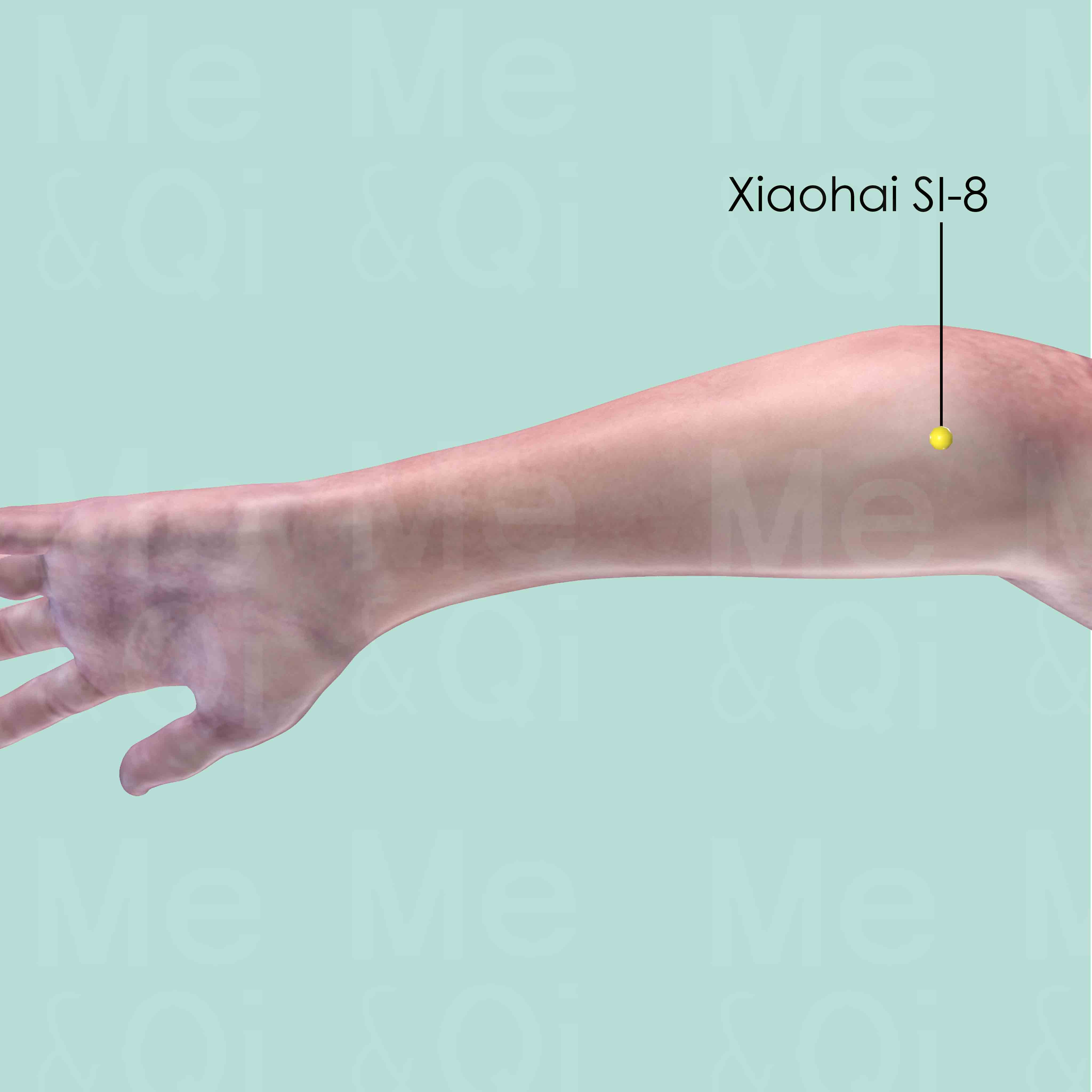Neck Gland Swellingaccording to TCM
Symptom family: Lymphatic Disorders
What is Neck Gland Swelling?
Neck gland swelling typically refers to the enlargement of the lymph nodes in the neck, often seen as a response to infection, inflammation, or other underlying conditions. These swollen glands can vary in size and are usually palpable and tender upon touch. The swelling is a sign that the body's immune system is fighting off an intruder, such as bacteria or viruses, but can sometimes indicate more serious health issues.
How does TCM View Neck Gland Swelling?
Traditional Chinese Medicine (TCM) interprets neck gland swelling as a manifestation of an imbalance within the body's Qi (vital energy) flow, influenced by external pathogens or internal Disharmony. TCM emphasizes the interconnectedness of the body's systems, viewing the swelling as a symptom of a broader imbalance.
The condition might be associated with Dampness, Heat, or Wind invading the body, disrupting the natural flow of Qi and leading to the accumulation of toxins which manifest physically as swollen glands. Identifying the precise pattern of Disharmony is essential for TCM practitioners to effectively address the root cause and restore balance.
Root Causes of Neck Gland Swelling in TCM
In TCM, neck gland swelling is often seen as a result of Dampness and Heat accumulating in the body, leading to the obstruction of Qi and Blood flow. For example, Damp-Heat can arise from an unhealthy diet or living in a damp environment, causing symptoms like swollen neck glands, fever, and a sticky taste in the mouth.
Similarly, Damp-Wind, often related to sudden changes in weather, can lead to neck gland swelling accompanied by aversion to cold and body aches. These conditions illustrate the body's response to environmental factors and internal imbalances, requiring tailored treatment to restore harmony.
Explore below more details about what might cause Neck gland swelling according to TCM.
- By Syndrome
- Dampness
- Heat
- Wind
Dampness
"Dampness" in TCM is a concept that describes a pattern of disharmony where the body accumulates excess moisture. Imagine the heavy, sticky feeling you get on a very humid day; that's similar to what dampness feels like internally. It can manifest as a sense of heaviness, bloating, sluggishness, or even a foggy mind. This condition is often thought to arise from environmental factors like living in a damp place, dietary habits that promote moisture in the body, or internal imbalances that hinder the body's ability to process fluids properly. In TCM, dampness can obstruct the normal flow of energy and fluids in the body, leading to various symptoms.... see more
Dampness Patterns That Can Lead to Neck Gland Swelling
Common Symptoms: Fever Feeling Of Heaviness Aversion To Cold Headaches Tight Feeling In Chest And Stomach Sticky Taste In The Mouth Absence Of Thirst Feeling Hot
| Pattern Name | Relevant Symptoms | Relevant Formulas |
|---|---|---|
| Damp-Heat | Swollen neck glands, Fever, Neck gland swelling, Headaches, Tight feeling in chest and stomach, Sticky taste in the mouth, Absence of thirst, Feeling hot, Feeling of heaviness, Bitter taste in the mouth, Acne... see more | Huo Xiang Zheng Qi San | Lian Po Yin | Yin Chen Hao Tang | Gan Lu Xiao Du Dan |
| Damp-Wind | Swollen neck glands, Aversion to cold, Fever, Neck gland swelling, Nausea, Perspiration, Occipital stiffness, Body pain, Muscle pain, Feeling of heaviness, Swollen joints... see more | Qiang Huo Sheng Shi Tang | Jiu Wei Qiang Huo Tang | Cang Er Zi San | Xiao Feng San | Ku Shen Tang | Hai Tong Pi Tang |
Heat
In TCM "Heat" signifies an excess of Yang energy, leading to an imbalance where heat predominates over the body's cool Yin aspects. This condition is metaphorically akin to an internal over-heating. Symptoms indicative of Heat can include feelings of warmth, fever, sweating, irritability, red face, thirst with a preference for cold drinks, and a rapid pulse. The tongue may appear red with a yellow coating. Unlike the common interpretation of heat in terms of temperature, in TCM, it represents a state of hyperactivity or inflammation in the body.... see more
Heat Patterns That Can Lead to Neck Gland Swelling
| Pattern Name | Relevant Symptoms | Relevant Formulas |
|---|---|---|
| Damp-Heat | Swollen neck glands, Fever, Neck gland swelling, Headaches, Tight feeling in chest and stomach, Sticky taste in the mouth, Absence of thirst, Feeling hot, Feeling of heaviness, Bitter taste in the mouth, Acne... see more | Huo Xiang Zheng Qi San | Lian Po Yin | Yin Chen Hao Tang | Gan Lu Xiao Du Dan |
Wind
In TCM "Wind" is a concept that represents a pattern of disharmony, often characterized by its sudden and unpredictable nature, much like a gusty wind changing direction without warning. This pattern is associated with symptoms that come and go quickly or move around the body, such as itching, tremors, or even certain types of pain. Wind is considered to be a primary cause of illnesses that have these rapidly changing characteristics. In TCM, external Wind often refers to illnesses that start suddenly, like the common cold, believed to be caused by external pathogenic factors like climatic changes. On the other hand, internal Wind can be linked to internal imbalances and can manifest in conditions like dizziness or spasms. ... see more
Wind Patterns That Can Lead to Neck Gland Swelling
| Pattern Name | Relevant Symptoms | Relevant Formulas |
|---|---|---|
| Damp-Wind | Swollen neck glands, Aversion to cold, Fever, Neck gland swelling, Nausea, Perspiration, Occipital stiffness, Body pain, Muscle pain, Feeling of heaviness, Swollen joints... see more | Qiang Huo Sheng Shi Tang | Jiu Wei Qiang Huo Tang | Cang Er Zi San | Xiao Feng San | Ku Shen Tang | Hai Tong Pi Tang |
TCM Herbal Formulas for Neck Gland Swelling
Addressing neck gland swelling in TCM involves formulas designed to expel Dampness, clear Heat, and restore the flow of Qi. Huo Xiang Zheng Qi San, enriched with Korean Mint, is utilized to transform Dampness and harmonize the stomach, making it suitable for Damp-Heat conditions.
For those affected by Damp-Wind, Qiang Huo Sheng Shi Tang, containing Notopterygium Roots, serves to dispel Wind-Damp and alleviate muscle pain. These formulas exemplify TCM's approach to treating neck gland swelling by focusing on the underlying patterns of Disharmony.
Explore below some TCM herbal formulas used to address neck gland swelling, organized by cause and by formula type.
- By Cause
- By Formula Type
- Dampness
- Heat
- Wind
- Formulas that clear heat and expel dampness
- Formulas that dredge and disperse external wind
- External formulas for external disorders
- Formulas that transform dampness and harmonize stomach
- Formulas that dispel wind-Damp
- Formulas that clear wind-Cold
Top Formula for Dampness:
Huo Xiang Zheng Qi San
Suitable for Dampness patterns that may cause neck gland swelling, such as Damp-Heat
Learn moreAll Formulas Recommended for Neck Gland Swelling Caused by Dampness
| Formula | Patterns Suitable For |
|---|---|
| Huo Xiang Zheng Qi San | Damp-Heat |
| Lian Po Yin | Damp-Heat |
| Yin Chen Hao Tang | Damp-Heat |
| Gan Lu Xiao Du Dan | Damp-Heat |
| Qiang Huo Sheng Shi Tang | Damp-Wind |
| Jiu Wei Qiang Huo Tang | Damp-Wind |
| Cang Er Zi San | Damp-Wind |
| Xiao Feng San | Damp-Wind |
| Ku Shen Tang | Damp-Wind |
| Hai Tong Pi Tang | Damp-Wind |
Top Formula for Heat:
Huo Xiang Zheng Qi San
Suitable for Heat patterns that may cause neck gland swelling, such as Damp-Heat
Learn moreAll Formulas Recommended for Neck Gland Swelling Caused by Heat
| Formula | Patterns Suitable For |
|---|---|
| Huo Xiang Zheng Qi San | Damp-Heat |
| Lian Po Yin | Damp-Heat |
| Yin Chen Hao Tang | Damp-Heat |
| Gan Lu Xiao Du Dan | Damp-Heat |
Top Formula for Wind:
Qiang Huo Sheng Shi Tang
Suitable for Wind patterns that may cause neck gland swelling, such as Damp-Wind
Learn moreAll Formulas Recommended for Neck Gland Swelling Caused by Wind
| Formula | Patterns Suitable For |
|---|---|
| Qiang Huo Sheng Shi Tang | Damp-Wind |
| Jiu Wei Qiang Huo Tang | Damp-Wind |
| Cang Er Zi San | Damp-Wind |
| Xiao Feng San | Damp-Wind |
| Ku Shen Tang | Damp-Wind |
| Hai Tong Pi Tang | Damp-Wind |
Formulas that clear Heat and expel dampness
These formulas are suitable for some neck gland swelling-causing patterns like Damp-Heat.
One such formula is Lian Po Yin, with goldthread rhizome as a key herb.
Other formulas of this category are listed in the table below.
All "formulas that clear heat and expel dampness" recommended for neck gland swelling
| Formula | Patterns Suitable For (if applicable) |
|---|---|
| Lian Po Yin | Damp-Heat |
| Yin Chen Hao Tang | Damp-Heat |
| Gan Lu Xiao Du Dan | Damp-Heat |
Formulas that dredge and disperse External Wind
These formulas are suitable for some neck gland swelling-causing patterns like Damp-Wind.
One such formula is Cang Er Zi San, with cocklebur fruit as a key herb.
Other formulas of this category are listed in the table below.
All "formulas that dredge and disperse external wind" recommended for neck gland swelling
| Formula | Patterns Suitable For (if applicable) |
|---|---|
| Cang Er Zi San | Damp-Wind |
| Xiao Feng San | Damp-Wind |
External formulas for External disorders
These formulas are suitable for some neck gland swelling-causing patterns like Damp-Wind.
One such formula is Ku Shen Tang, with sophora root as a key herb.
Other formulas of this category are listed in the table below.
All "external formulas for external disorders" recommended for neck gland swelling
| Formula | Patterns Suitable For (if applicable) |
|---|---|
| Ku Shen Tang | Damp-Wind |
| Hai Tong Pi Tang | Damp-Wind |
Formulas that transform Dampness and harmonize Stomach
These formulas are suitable for some neck gland swelling-causing patterns like Damp-Heat.
One such formula is Huo Xiang Zheng Qi San, with korean mint as a key herb.
Formulas that dispel Wind-Damp
These formulas are suitable for some neck gland swelling-causing patterns like Damp-Wind.
One such formula is Qiang Huo Sheng Shi Tang, with notopterygium root as a key herb.
Formulas that clear Wind-Cold
These formulas are suitable for some neck gland swelling-causing patterns like Damp-Wind.
One such formula is Jiu Wei Qiang Huo Tang, with notopterygium root as a key herb.
Acupoints for Neck Gland Swelling
TCM also employs acupressure and acupuncture techniques, targeting specific points to enhance treatment efficacy. Erheliao TB-22 and Tianjing TB-10, located along the Triple Burner Channel, are points known for their ability to expel Wind and ease pain, making them beneficial for symptoms like neck gland swelling.
Similarly, Tianrong SI-17 and Xiaohai SI-8 from the Small Intestine Channel can help clear Toxic Heat and resolve Dampness. These points demonstrate how TCM uses targeted interventions to address specific symptoms while maintaining a focus on holistic well-being.
Explore below some acupoints used to address neck gland swelling, organized by meridian.
- By Meridian
- Triple Burner Channel
- Small Intestine Channel
- Gall Bladder Channel
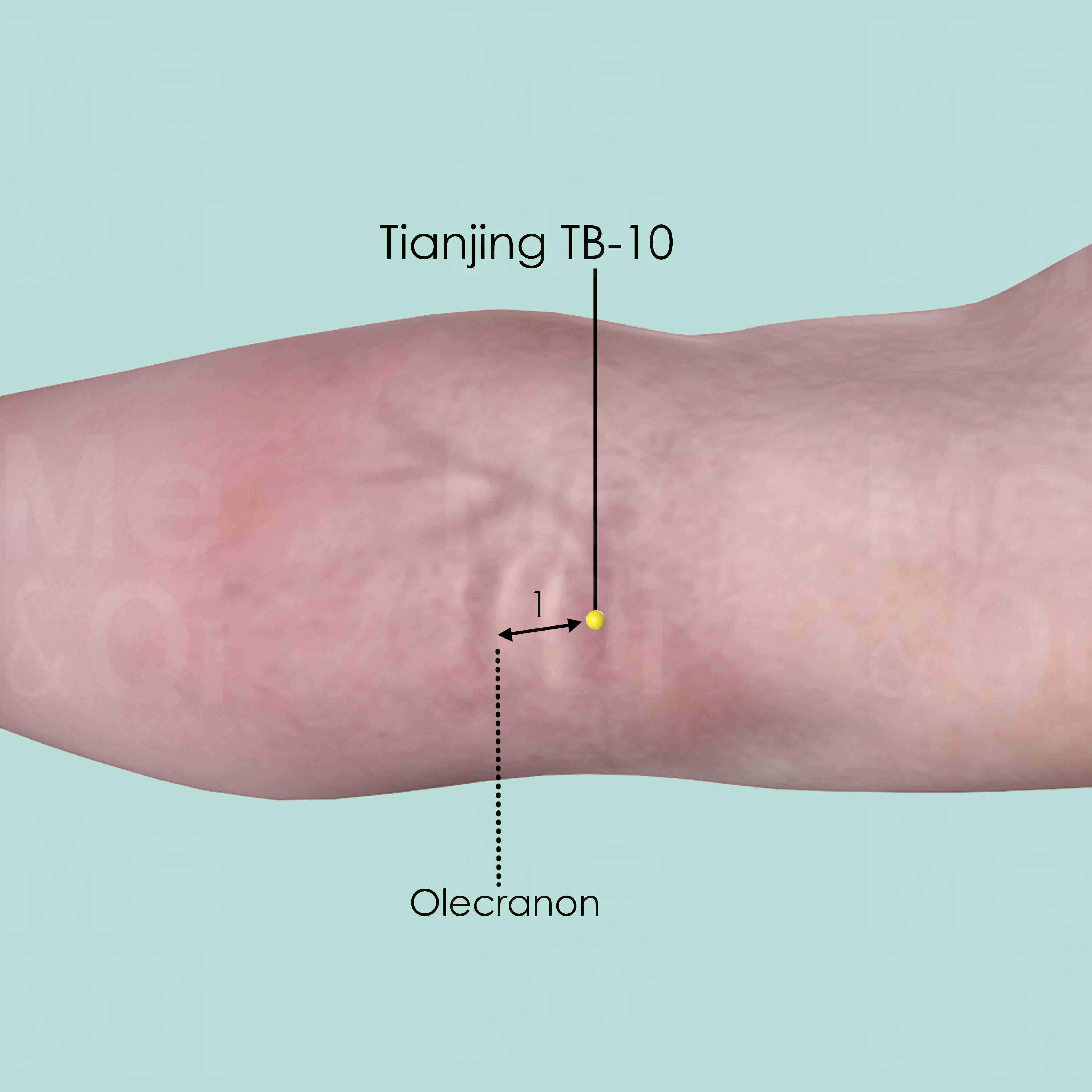
Tianjing TB-10
When the elbow is flexed, Tianjing TB-10 is in the depression about 1 cun superior to the olecranon.
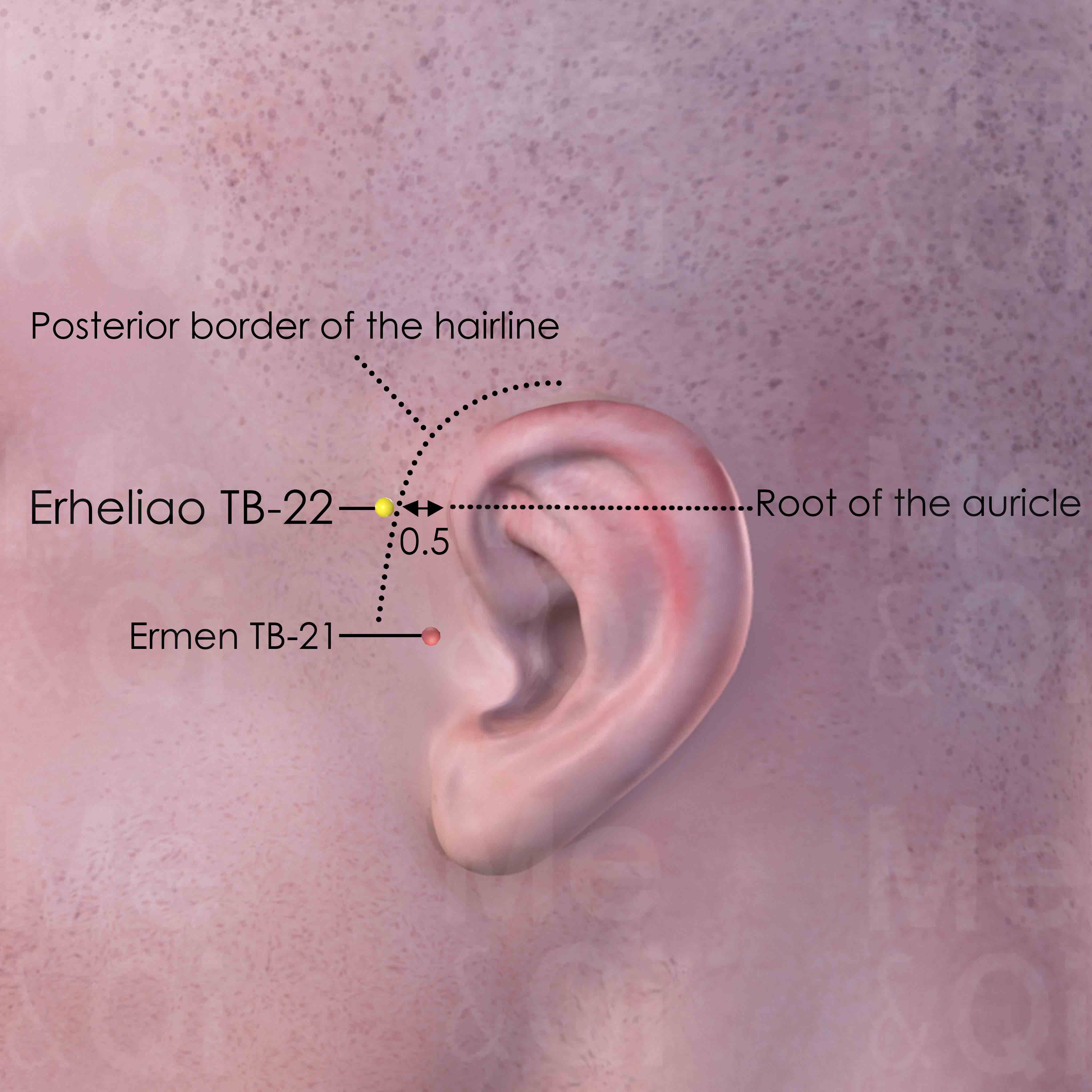
Erheliao TB-22
Anterior and superior to Ermen TB-21, level with the root of the auricle, on the posterior border of the hairline of the temple where the superficial temporal artery passes.
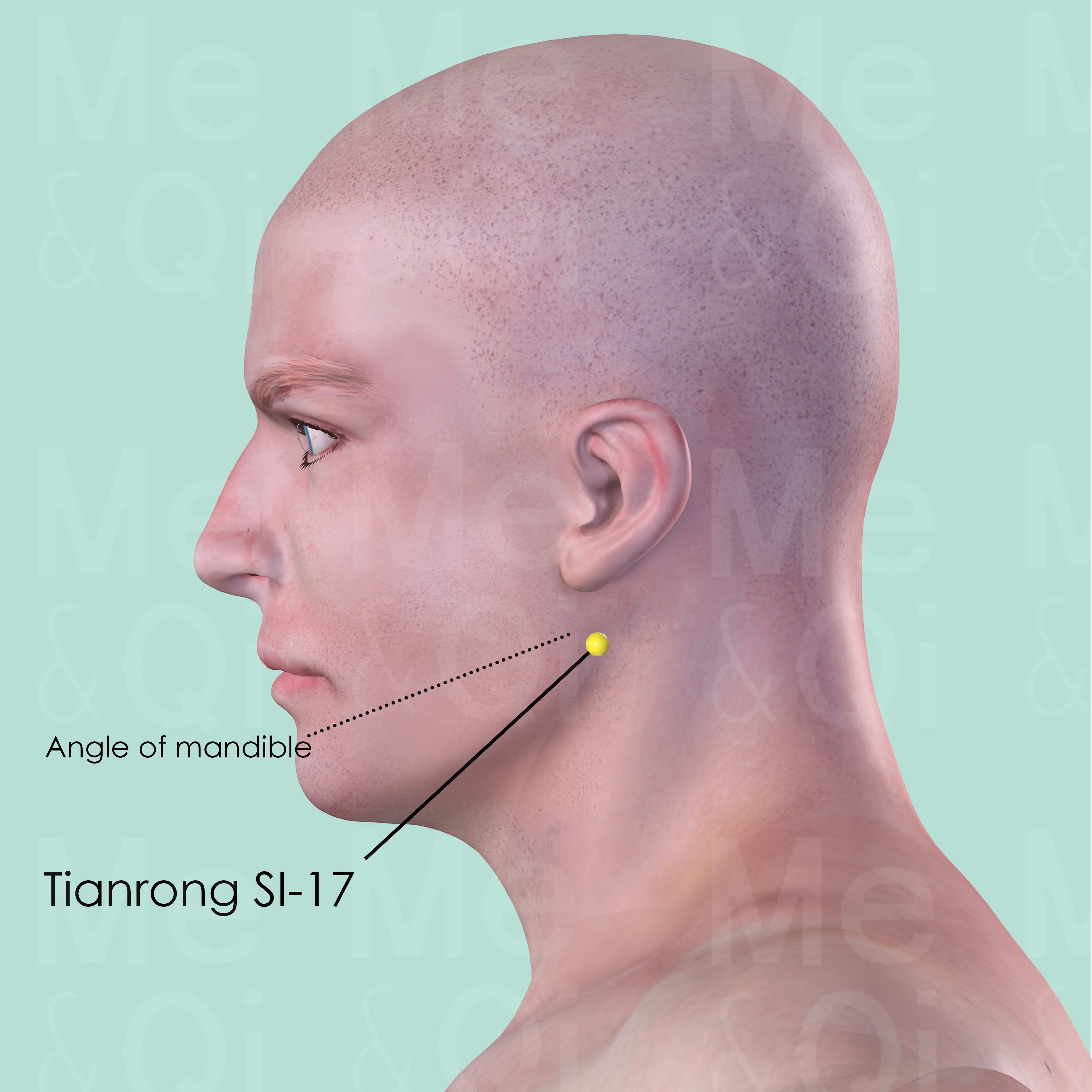
Tianrong SI-17
Posterior to the angle of mandible, in the depression on the anterior border of sternocleidomastoid muscle.
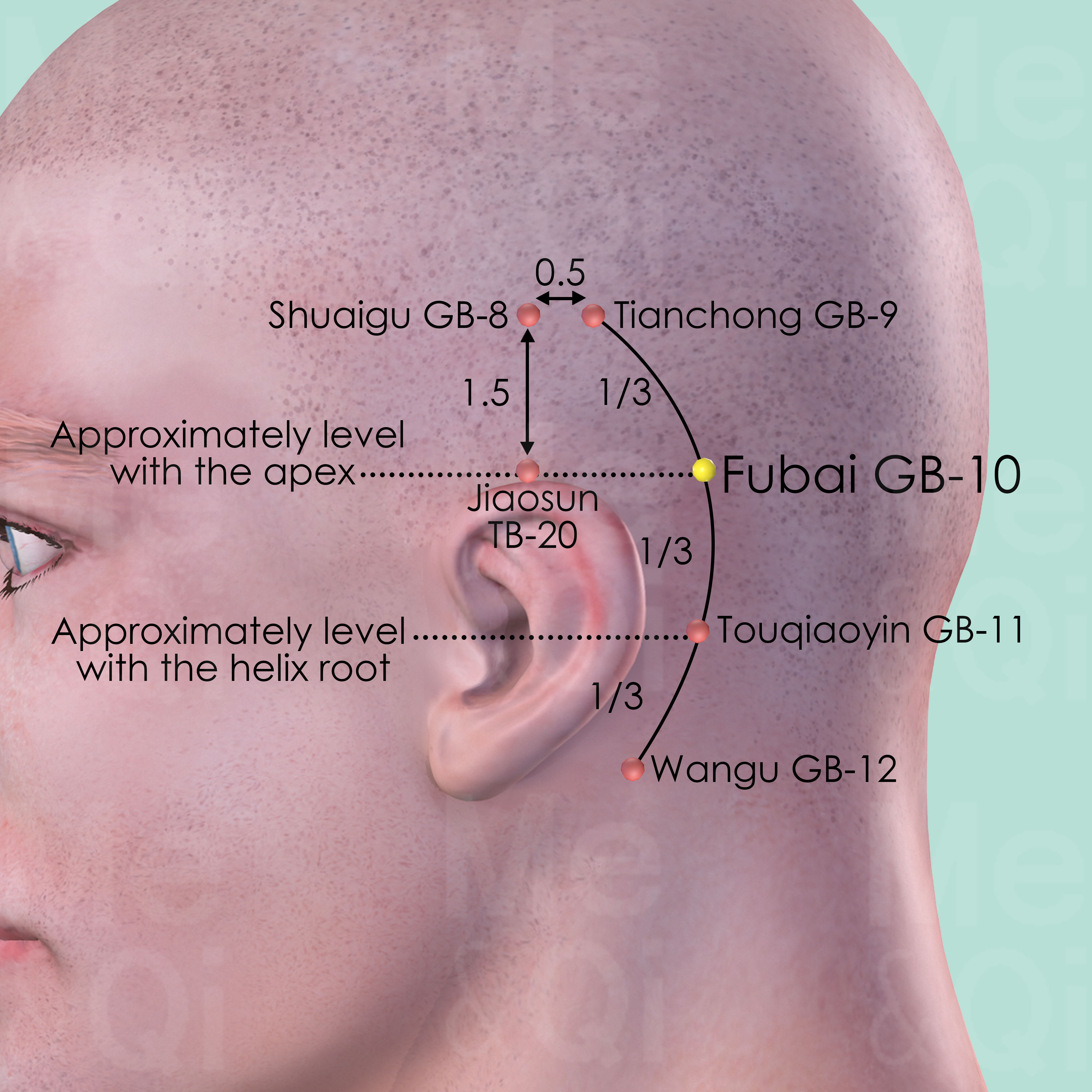
Fubai GB-10
Posterior and superior to the mastoid process, at the junction of the upper third and the two lower thirds of the curved line connecting Tianchong GB-9 and Wangu GB-12.

